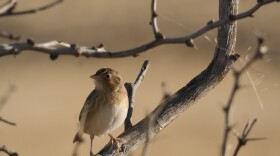
Nature Notes
Why do rattlesnakes rattle and hummingbirds hum?
How do flowers market themselves to pollinators?
Why do tarantulas cross the road?
Nature Notes investigates questions like these about the natural world of the Chihuahuan Desert region and the Llano Estacado every week. Through interviews with scientists and field recordings, this Marfa Public Radio original series reveals the secrets of desert life.
Join host Dallas Baxter on Tuesdays and Thursdays at 7:45 am during Morning Edition and 4:45 pm during All Things Considered. New episodes premier on Thursdays and replay on Tuesdays. Episodes are written and produced by Andrew Stuart and edited by Marfa Public Radio and the Sibley Nature Center in Midland, Texas.
-
Chihuahuan Desert grasslands are the main winter home for birds known as grassland specialists – chestnut-collared and thick-billed longspurs, lark buntings and horned larks, Sprague’s pipits and diverse sparrows. These birds are deeply imperiled, and supporting them is a top priority for West Texas conservationists.
-
Extreme drought tests nature’s resilience. And birds are a particularly vivid example of how the creature world responds to drought, and to a landscape recovering from it.
-
Big Bend Ranch State Park is promoted as “the Other Side of Nowhere,” and the park’s River Road – FM 170 between Lajitas and Redford – fits that billing. It’s a breathtaking landscape of volcanic badlands and imposing canyons, and it can seem like a timeless wilderness, untouched by history.
-
Facilitated by the nonprofit Texan by Nature, and funded by oil giant ConocoPhillips, the Delaware River Basin Restoration project aims to revive an historic stream in Culberson County, 70 miles north of Van Horn.
-
Known only from sites in southern Presidio and Brewster counties, “Big Bend Bold” rock art is distinctive for the size and style of its imagery, which is painted in black or dark green. The style was named by archeologist Tim Roberts, who argues it was created by Indigenous Big Bend farmers and foragers at the time the Spanish first arrived here.
-
It’s a fragile little grass, with a fragile future. Guadalupe fescue was first identified in the Guadalupe Mountains in 1932 – but hasn’t been seen in its namesake Texas range for decades.
-
Texas state parks showcase a host of treasured resources – canyons and caverns, dinosaur tracks and hiking trails, waterfalls and whitewater rivers. The parks also preserve a remarkable archeological record, rich evidence of Texas’s Indigenous past.
-
Researchers have studied the iconic ocotillo plant extensively. Yet they didn’t know the answer to a basic question: how long do ocotillos live? Biologist Peter Scott sought the answer in Big Bend National Park.
-
Arizona cypress can grow 80 feet high, with blue-green to gray-green foliage. These Southwestern conifers are “obligate seeders” – they require fire to reproduce – and changing fire patterns have put them at risk.
-
Carpenter bees are known to “rob” nectar – to take the sweet stuff without moving any pollen. But in Big Bend at least, carpenter bees and ocotillos have a mutualistic relationship, one that benefits both lifeforms.










